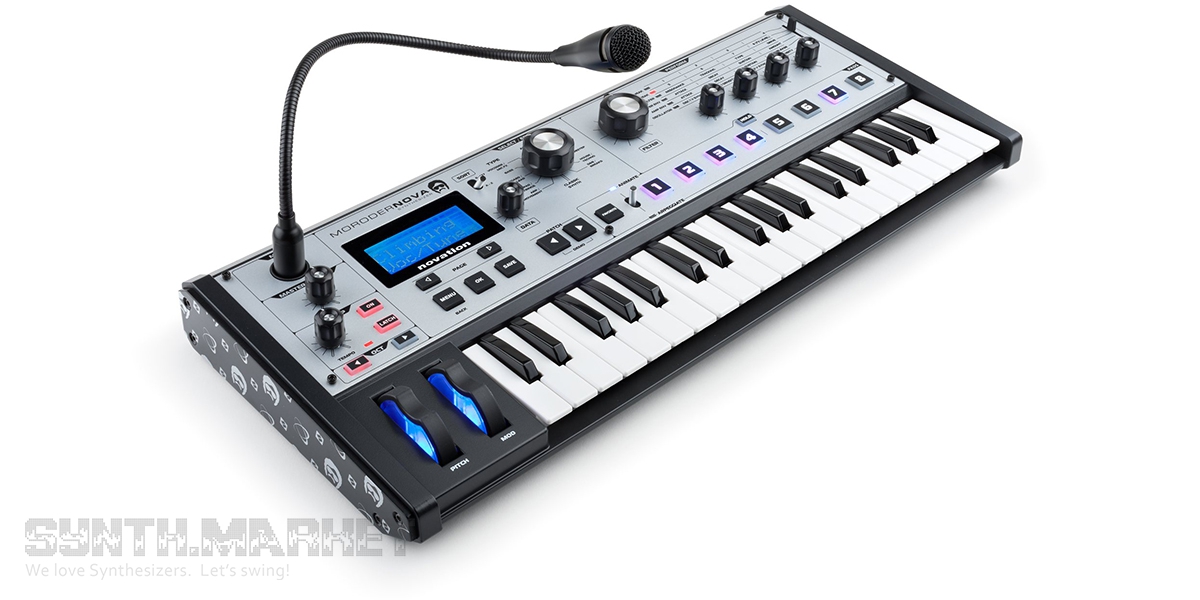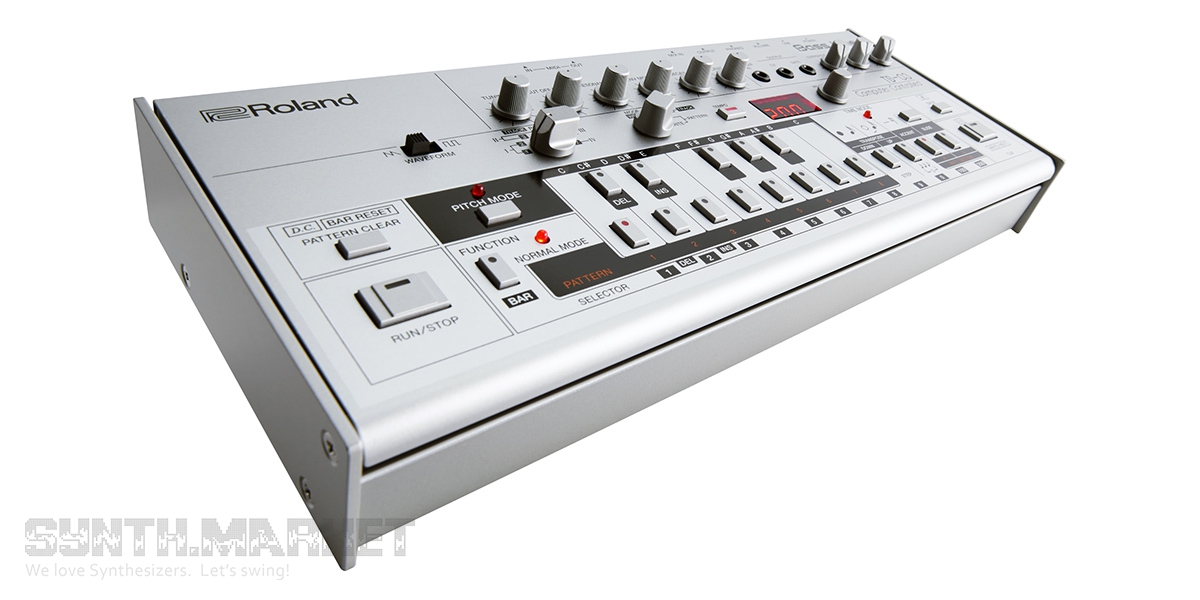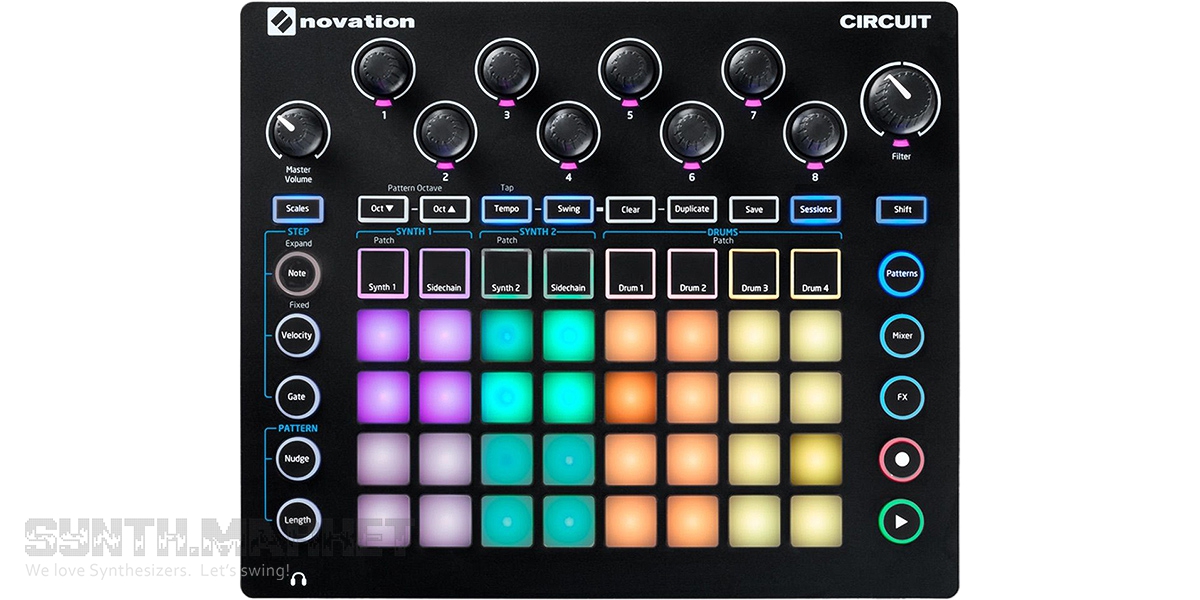Now then, the digital setup, which we propose as the best option for a beginner musician, consists of three instruments: Novation MiniNova polyphonic synthesizer&vocoder, Roland TB-03 bass synthesizer and Novation Circuit groovebox. Together they will cost about $1000.
Novation MiniNova is a compact digital synthesizer for a pleasant price of $400 for a new one and about $250 for a used one in a good condition. Its calling card is a powerful sound engine, borrowed from the flagship UltraNova synthesizer, which allows you to create and manage fairly complex patches, supports 18-voice polyphony, and also contains an extensive effects processor. The keyboard contains 3 octaves of reduced keys.
The instrument can store 256 presets, which are quite convenient to navigate through due to a separate control and their division into categories: types (like pads or, for example, leads) and musical genres. Of course you can also save and load your preset banks: there are 128 free cells assigned for this. The majority of the tone parameters are controlled by just four knobs, the parameters are selected using a matrix, but the filter cutoff frequency is selected separately. In addition, the instrument has an arpeggiator with 33 work patterns and an Animate section of special performance effects, all controlled by eight pads. Another nice feature is a special software that allows you to control the parameters of the synthesizer using a computer, which makes the control process even more clear and understandable.
Now let’s have a closer look at the sound engine. Each patch allows you to use three oscillators, two ring modulators, a noise generator and two filters in each patch. In addition, each patch has 20 assignable modulation cells. The waveforms of the oscillators include standard sine, triangle, saw, pulse, square, as well as nine combinations of saw and square along with 20 digital and 36 wavetable timbres. There are as many as 14 types of filters in the synthesizer: low-pass with a 6, 12, 18, 24 dB per octave depth of cut, band-pass with a 6:6, 6:12, 12:6, 6:18, 18:6, 12:12 dB per octave depth of cut and high-pass with a 6, 12, 18, 24 dB per octave depth of cut. As for modulation sources, the instrument offers six envelope generators and three low frequency oscillators (LFOs), a modulation wheel is located next to the keyboard, and an expression pedal can be connected. You can apply modulation to 66 different parameters, among which, besides obvious ones, there is also a recursive modulation. The effects section of the sound engine includes distortion, compressor, chorus / phaser, delay, reverb and equalizer. Another part of the instrument is a 12-band vocoder with the VocalTune function, which is suitable not only for changing the voice timbre, but also for letting the signals from other instruments through the effects section of the MiniNova synth.
The weakest point of the instrument is the keyboard, which breaks down pretty quickly, you should pay special attention to it if you buy an already used instrument.
In the role of a bass synthesizer we propose Roland TB-03, which is essentially a direct descendant of the TB-303 - a legendary analog synthesizer that won the hearts of electronic musicians in the 80's with its fat psychedelic sound. The cost of TB-03 is $350 for a new one (it is currently difficult to find on sale) and about $250 for a used one. TB-03, in contrast to the TB-303, is a digital instrument that, thanks to ACB technology, emulates the sound of the original analog synthesizer very accurately.
The appearance and basic parameters of the instrument have remained unchanged. You can choose from two waveforms: square and saw. The timbre can be controlled with a resonant filter, tone adjustment, envelope, delay and accent. The sequencer also has not changed much, it still has Pitch and Time recording modes, but there is also a new Step mode that allows you to record the patterns step by step and there is a display, which shows the exact tempo for each step. You can start the sequencer not only with a special button, but also with the help of a trigger input.
There are some new features to the device, of course. Among them, the already mentioned display, on which you can easily track the parameter change, which simplifies the the synthesizer management and the sequencer, in addition to the new working mode, has the ability to fine tune the tempo now, as well as the shuffle feature. In addition, the instrument has an effect section that includes overdrive, reverb and delay which allow you to change the sound character, making it dense and shrill or smooth and meditative.
Novation Circuit is an another great instrument that seamlessly complements the previous ones. This small but powerful machine combines the functionality of a synthesizer, a sampler and a sequencer, in other words - it's a groovebox. Its cost is $300 for a new one and $220 for a used one.
It has a two-part synthesizer engine, borrowed from Nova's synthesizers, a 16-step sequencer, and a four-channel percussion sound generator that turns Circuit into a fairly versatile independent instrument that allows you to record and edit any ideas on the fly. The audio engine supports 6-voice polyphony for each of the two synthesizer parts, and also controls all eight parameters of the device. There is also an envelope control for the drum-machine. The instrument can store 64 synthesizer and 64 percussion patches. Also, you’ll find a mixer in the instrument, using which you can adjust the levels, and mute/unmute separate channels. The master bus has a low/high-pass filter. In addition, the device has an effects section, which includes 16 delays, 8 reverbs and a sidechain effect with seven operation modes.
The instrument sequencer supports a 6-channel recording (2 synthesizer, 4 percussion sounds), and there can be up to 8 patterns on each channel. You can record music in real time and then the notes and automation (the device has 50 automation parameters) can be automatically adjusted to the steps. The internal range of tempos is from 40 to 240 beats per minute, but the synthesizer supports synchronization with external sources, in which case the range is slightly expanded (from 30 to 300 beats per minute).
All the instruments listed above can be connected to the PC via a USB cable and also can share MIDI-messages. Summing up, they all are partially interchangeable, but together they allow you to do almost anything. All of them are very convenient and easy to handle, and are also great for live performances as well as for using them at home.
It should also be mentioned that any of these instruments can easily find a new owner in case you get bored playing around with them and you will be able to update your setup, bringing it to the new heights. Instead of TB-03, you can consider the TR-09 option, instead of Circuit - Circuit Mono Station. The lead synth can be replaced by microKORG /microKORG S / microKORG XL+ for about the same price. In case you need more functionality and you are ready to sacrifice the variability of three instruments - Roland JD-Xi and Roland TR-8 / Roland TR-8S are waiting for you. Two instead of three and for the same price.




